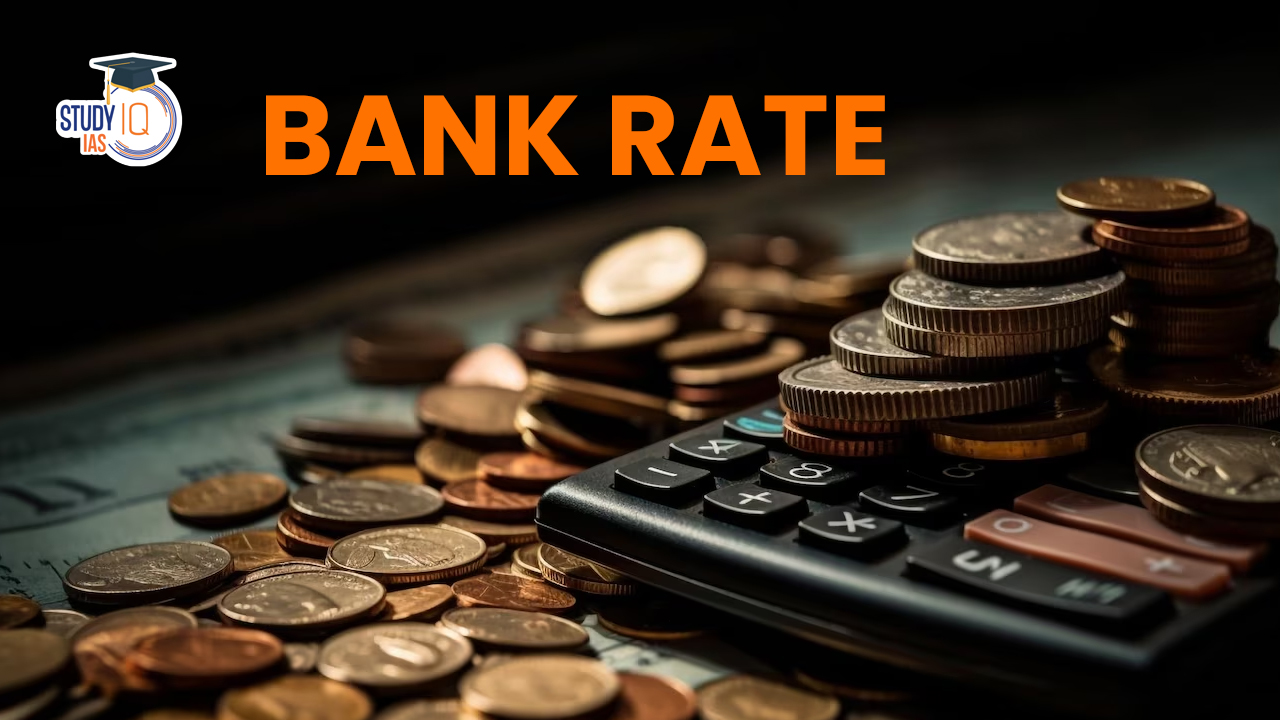Table of Contents
The banking sector plays a pivotal role in any economy, and one of the most critical aspects of this sector is monetary policy, which central banks use to regulate the supply of money. Among the various monetary tools available, the bank rate is a key instrument that influences lending rates, inflation, and economic growth. In this article, we will delve into the definition of the bank rate, its types, how it works, and examples to better understand its significance, particularly from the perspective of the UPSC exam.
What is Bank Rate?
Bank rate refers to the rate at which a central bank lends money to commercial banks or financial institutions within its jurisdiction. It is considered a benchmark rate for lending within the banking sector and serves as a tool for regulating liquidity and influencing interest rates in the economy. The bank rate is typically higher than other policy rates and is used to signal the central bank’s monetary policy stance.
Key Features:
- Long-term lending: Unlike the repo rate, which deals with short-term borrowing (overnight or short-term liquidity needs), the bank rate is applied to long-term loans.
- No collateral: Central banks lend to commercial banks at the bank rate without any collateral.
- Influence on other rates: Changes in the bank rate affect other interest rates in the economy, including lending rates for consumers and businesses.
Read about: Banking System in India
Types of Bank Rate
The concept of the bank rate may vary in different economies based on monetary policy frameworks. Here are some variations:
- Nominal Bank Rate: This is the stated rate of interest without taking inflation into account. It reflects the percentage at which banks borrow from the central bank, unaffected by inflationary pressures.
- Effective Bank Rate: The effective bank rate reflects the actual cost of borrowing for commercial banks, taking into account compounding effects and other hidden costs.
- Discount Rate: In some countries, particularly the United States, the term “discount rate” is used in a similar context. The Federal Reserve lends to banks at the discount rate. Although different from the bank rate in a technical sense, both have similar functions of influencing monetary policy.
- Penal Rate: Sometimes, a higher rate than the standard bank rate is applied to banks when they borrow beyond a prescribed limit or fail to maintain required reserves. This is known as the penal rate.
Bank Rate Policy
In India, the Bank Rate is a key policy rate determined by the Reserve Bank of India (RBI). It is used as a tool to influence the cost of borrowing and overall monetary conditions in the economy. By adjusting the Bank Rate, the RBI can encourage or discourage borrowing, influence interest rates, and manage liquidity in the banking system. The Bank Rate policy is an important component of the RBI’s monetary policy framework aimed at achieving price stability, promoting economic growth, and maintaining financial stability in India.
Read about: Public Sector Banks
Bank Rate in India
The Reserve Bank of India (RBI) takes into consideration several factors when determining the Bank Rate. These factors include:
Inflation
The RBI assesses the prevailing inflation rate and its outlook. Higher inflation may prompt the RBI to raise the Bank Rate to curb inflationary pressures.
Economic Growth
The RBI considers the state of economic growth and overall macroeconomic conditions. The Bank Rate may be adjusted to stimulate or moderate economic activity based on growth objectives.
Monetary Policy Objectives
The RBI aligns the Bank Rate with its monetary policy objectives, which include price stability, growth, and financial stability. The rate is set to achieve these objectives effectively.
Market Conditions
The RBI analyzes market conditions, including interest rate levels, credit demand, liquidity, and investor sentiment. These factors influence the decision on adjusting the Bank Rate.
The frequency of changes to the Bank Rate depends on the prevailing economic conditions and monetary policy stance. The RBI may choose to change the Bank Rate during its periodic monetary policy review meetings, typically held every two months. However, the RBI can also make off-cycle changes if there is a need to address emerging economic challenges or maintain policy effectiveness. The timing and frequency of Bank Rate changes are determined by the RBI based on its assessment of the economic situation and policy requirements.
Read about: List of RBI Governors of India
Bank Rate at Present
As of the latest update in 2024, the Reserve Bank of India (RBI) has kept the bank rate steady at 6.75%. This rate is primarily used as a reference point for lending between the RBI and other financial institutions. It’s a critical tool in the RBI’s monetary policy, helping to control liquidity and inflation in the economy.
Read about: Types of Banks in India
Difference Between Bank Rate and Repo Rate
Here is a tabular representation of difference between Bank Rate and Repo rate in a tabular form.
| Bank Rate | Repo Rate | |
| Definition | The rate at which the central bank lends money to commercial banks or financial institutions. | The rate at which banks borrow money from the central bank by selling eligible securities. |
| Purpose | Influences borrowing costs and overall monetary conditions in the economy. | Manages short-term liquidity in the banking system and signals the central bank’s monetary policy stance. |
| Level | Typically higher than other policy rates and serves as a benchmark rate for lending within the banking sector. | Usually lower than the Bank Rate and repo rates of longer tenures, serving as the primary policy rate. |
| Borrower | Commercial banks and financial institutions borrow from the central bank. | Banks borrow from the central bank by selling eligible securities. |
| Collateral | Generally, the central bank may not require specific collateral for lending at the Bank Rate. | Banks provide eligible securities as collateral to borrow funds from the central bank at the repo rate. |
| Monetary Policy Signal | Reflects the central bank’s monetary policy stance and its views on overall economic conditions. | Indicates the central bank’s stance on short-term interest rates and liquidity management. |
| Impact on Market | Changes in the Bank Rate can influence lending rates, credit availability, and overall market sentiment. | Adjustments in the repo rate affect short-term borrowing costs, interbank liquidity, and money market rates. |
Read about: Indian Financial System
Bank Rate UPSC
Understanding the Bank Rate is crucial for candidates preparing for the UPSC (Union Public Service Commission) examination, particularly those focusing on economics and monetary policy. The Bank Rate falls under the domain of the Indian economy and financial system, which is an integral part of the UPSC Syllabus. Familiarity with the Bank Rate enables candidates to grasp concepts related to monetary policy, interest rates, and liquidity management. Aspirants can enhance their preparation through UPSC Online Coaching, which provides comprehensive coverage of such topics, along with access to UPSC Mock Test for practice and self-assessment.
Read about: India’s GDP Growth Rate


 World Oceans Day 2025, History, Theme, S...
World Oceans Day 2025, History, Theme, S...
 World Environment Day 2025, Theme, Histo...
World Environment Day 2025, Theme, Histo...
 Unemployment Rate in India, Current Rate...
Unemployment Rate in India, Current Rate...





















